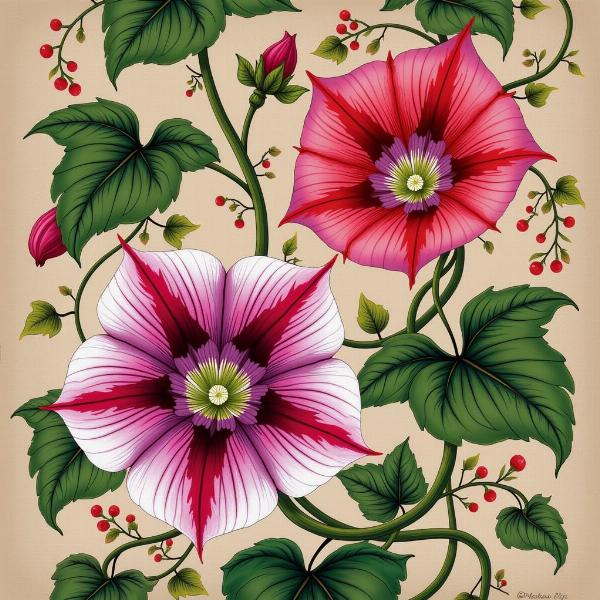Morning glory, a vibrant flower that unfurls its petals with the sunrise, holds a special place in many cultures, including India. Understanding the morning glory meaning in Hindi adds another layer of appreciation for this beautiful bloom. This article explores the various interpretations and cultural significance of the morning glory in the Indian context.
The Cultural Significance of Morning Glory in India
In India, the morning glory, known as “कल्याणी” (kalyani) or “विष्णुकान्ता” (vishnukāntā), often adorns temples and is used in religious ceremonies. Its association with deities like Vishnu and Krishna adds a spiritual dimension to its beauty. The ephemeral nature of the bloom, lasting only a single day, symbolizes the transient nature of life and the importance of cherishing each moment. The flower’s ability to close at night and reopen in the morning is also seen as a representation of rebirth and renewal.
Morning Glory Meaning in Hindi: Exploring the Linguistic Roots
The Hindi names for morning glory, “kalyani” and “vishnukāntā,” reveal much about its perceived qualities. “Kalyani” translates to “auspicious” or “beautiful,” reflecting the flower’s aesthetic appeal and its association with positive energies. “Vishnukāntā,” meaning “beloved of Vishnu,” underscores its sacred status in Hinduism.
Morning Glory in Literature and Art
 Traditional Indian painting of morning glory flowers
Traditional Indian painting of morning glory flowers
The morning glory has inspired countless poets and artists throughout Indian history. Its delicate beauty and symbolic richness have made it a recurring motif in classical literature and traditional art forms. From ancient Sanskrit poetry to contemporary paintings, the morning glory continues to captivate and inspire.
Different Colors, Different Meanings?
While the blue morning glory is most commonly associated with Vishnu, the flower comes in various colors, each potentially carrying its own subtle symbolism. For instance, white morning glories might be associated with purity, while pink ones could represent love and affection. However, these interpretations can vary regionally and culturally.
What does the Morning Glory Symbolize?
- Ephemeral Beauty: The short lifespan of the morning glory emphasizes the transient nature of life.
- Spiritual Significance: Its use in religious ceremonies and association with deities signifies its sacred status.
- Renewal and Rebirth: The closing and reopening of the flower symbolizes cycles of life and death.
- Love and Affection: Particularly the pink variety, can represent romantic love or deep affection.
Morning Glory: More Than Just a Flower
Beyond its aesthetic and spiritual significance, the morning glory also holds medicinal properties in some traditional practices. Its seeds and leaves have been used in various herbal remedies. However, it’s crucial to consult with qualified professionals before using any plant for medicinal purposes.
Conclusion: Appreciating the Morning Glory
Understanding the morning glory meaning in Hindi deepens our appreciation for this delicate flower. Its beauty, symbolism, and cultural significance make it more than just a pretty bloom. It’s a reminder of life’s fleeting nature, the importance of spirituality, and the beauty of renewal. From its role in religious ceremonies to its presence in literature and art, the morning glory continues to enchant and inspire.
FAQ: Common Questions about Morning Glory
- What is the most common color of morning glory in India? Blue is the most common color, often associated with Lord Vishnu.
- Is morning glory an annual or perennial plant? Most morning glories are annuals, meaning they complete their life cycle in a single growing season.
- What is the best time to see morning glories in bloom? As their name suggests, morning glories bloom early in the morning and typically close by midday.
- Can I grow morning glories in my garden? Yes, morning glories are relatively easy to grow from seeds.
- Are all parts of the morning glory plant safe to consume? No, some parts, especially the seeds, can be toxic if ingested in large quantities. Always consult with a healthcare professional before using any plant for medicinal purposes.
- What is the significance of the morning glory closing at night? The closing and reopening of the flower is often seen as a symbol of renewal and rebirth.
- What is the meaning of “vishnukāntā”? It means “beloved of Vishnu,” highlighting the flower’s sacred status in Hinduism.
Discover More about Hindi Meanings and Indian Culture
Explore other fascinating aspects of Hindi language and Indian culture on our website. Learn about shiv chalisa meaning in hindi or explore baby name in hindi a to z. You can also delve into the meaning of words like bask meaning in hindi or bhur meaning in hindi.
Meaning-Hindi.in is your trusted partner for professional translation services, specializing in Hindi and a wide range of other languages. We offer comprehensive solutions for businesses, legal professionals, academics, and individuals, covering everything from document translation to website localization. Our expertise includes business and commercial translation, certified and legal document translation, technical and user manual translation, website and localization services, educational and academic translation, express translation, and specialized industry translation. Need accurate and reliable translation services? Contact us today at [email protected] or call us at +91 11-4502-7584. Meaning-Hindi.in is dedicated to bridging language barriers and facilitating clear communication.